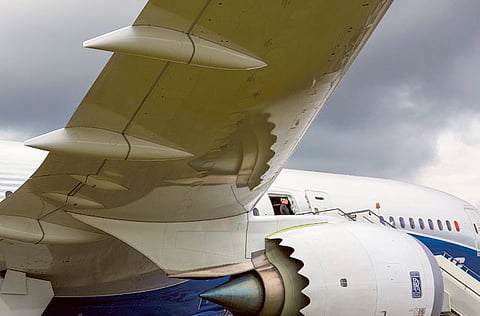Aviation sector flies into Farnborough at cruising speed
Boeing says airlines will need almost 37,000 new planes to meet the rising demand

Farnborough, United Kingdom: Aircraft makers gathering for the Farnborough airshow this week look to build on already robust passenger plane sales, and Airbus may use the event to launch an upgrade of its A330 jet.
“Manufacturers are showing particularly high order books,” equal to more than eight years of plane production, noted Alain Guillot, an aerospace analyst at consultants AlixPartners.
But the biennial Farnborough International Air Show, south-west of London, could see a slowdown in orders compared with previous record years, even though the industry is far from threatened.
The US group Boeing, which typically goes head-to-head with its European rival Airbus at Farnborough, forecast on Thursday that global passenger numbers would grow by 5.0 per cent annually over the next 20 years.
Boeing said airlines would need almost 37,000 new planes over the same period to meet the rising demand — suggesting that some spectacular orders could be unveiled between now and 2034.
According to Guillot, the sector is at a mature stage regarding aircraft development programmes.
In the absence of truly new technologies or revolutionary materials — such as light-weight carbon composites used in new fuel-efficient planes — the launch of a brand new passenger jet is not envisaged before five to seven years.
This has left Airbus and Boeing to modernise current models, which they are doing with their respective medium-haul A320 and 737 planes. Brazil’s Embraer has meanwhile launched the E2, a new version of its regional E-jets series, which could see new orders this week.
Regarding modernisation of long-haul planes, Boeing launched in November the 777X, a new version of its jumbo that seats between 350 and 450 passengers. Sector watchers are now looking to see if Airbus will proceed with the A330neo, providing the long-standing A330 with a more fuel-efficient engine.
Airbus chief executive Fabrice Bregier last week said a decision to re-engine the A330 would be made “before the end of the year”, and the chance of an announcement is on the industry’s radar at Farnborough.
In service since 1993, Airbus has sold about 1,300 A330s, of which the vast majority are still in service. It is thought that the A330neo could potentially sell more than 1,000 units, according to Bregier.
Addison Schonland of US consultants AirInsights believes the launch of the A330neo would be a good response to Boeing’s 787 Dreamliner.
“Airbus can price the A330neo far below the 787 and keep its customers happy,” he said.
“For instance we think the A330neo could provide about 75 per cent of the performance of the 787 at 50 per cent of the price. Of course this makes it attractive, plus it’s lower risk because it has a lot less high technology.”
Even without the neo model, Airbus can count on its A350, due to enter service at the end of the year, and expected to make flypasts at Farnborough.
Using composite materials, the A350 is another rival for the Dreamliner. Qatar Airways, launch-customer of the A350, plans to unveil its plane’s interior at the show.
While Farnborough focuses mainly on civilian aircraft, there is also room for the military sector to showcase latest plane models. But Farnborough might miss out on the US F-35 fighter jet — which would be a blow to organisers.
The first international appearance of the furtive F-35, set for Britain last Friday, was cancelled as the plane remains grounded in the United States, in an embarrassing setback for the costly programme.
It had been due to take part in a British military aviation display, the Royal International Air Tattoo, ahead of its formal presentation at Farnborough.
Lorraine Martin, general manager of the F-35 programme at US defence firm Lockheed Martin, said she still hoped the planes would make it to the airshow.
Both the US Air Force and Navy have ordered a halt to all F-35 flights following a June 23 engine fire on one of the planes, which at $400 billion (€300 billion) is most expensive weapons project in US history.
Sign up for the Daily Briefing
Get the latest news and updates straight to your inbox



